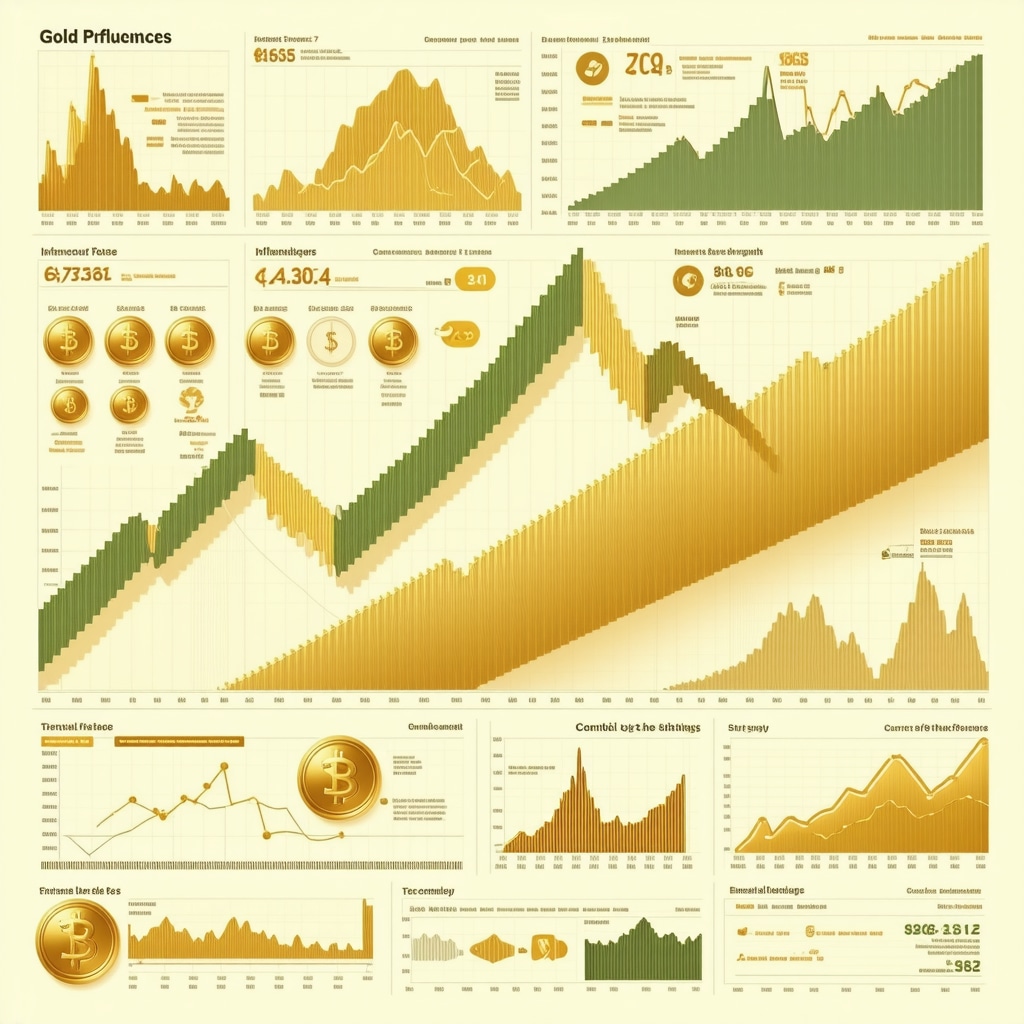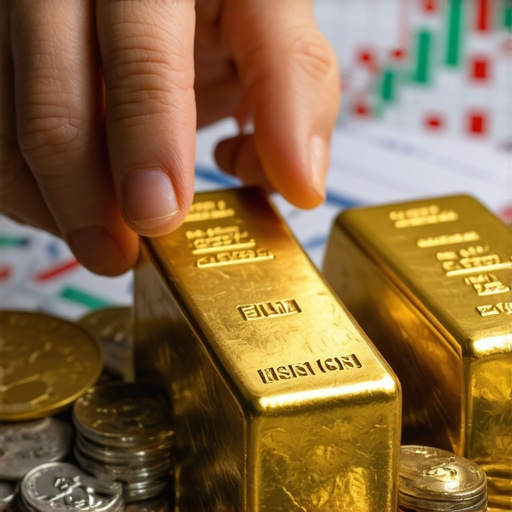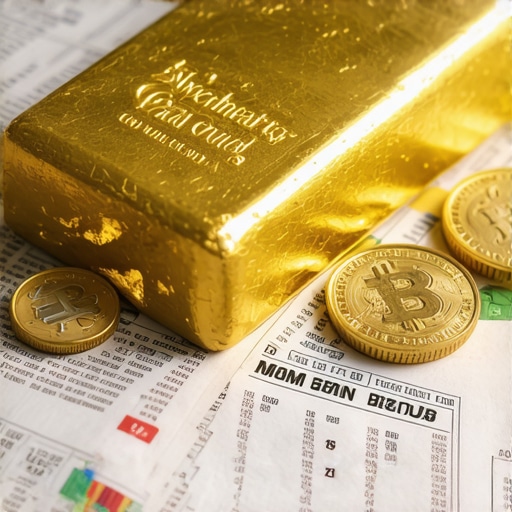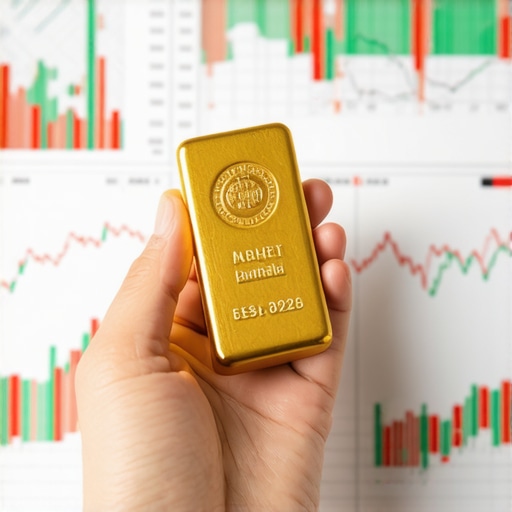Discovering Gold’s Timeless Allure: Why Beginners Should Consider Investing Now
Investing in gold is more than just buying a shiny metal; it’s an age-old strategy for wealth preservation and portfolio diversification. For beginners, stepping into the gold market might seem daunting, but with the right guidance, it’s an achievable and rewarding journey. Gold’s unique ability to hedge against inflation and economic uncertainty makes it a compelling asset, especially as global markets fluctuate. This guide will illuminate the essential steps to help newcomers start investing in gold confidently and wisely.
Mapping the Terrain: Understanding the Diverse Gold Investment Vehicles
Before diving in, investors must grasp the various forms gold investments take. Physical gold, such as coins and bars, offers tangible ownership but requires secure storage and insurance. Alternatively, gold exchange-traded funds (ETFs) provide liquidity and ease of trading without the hassles of physical custody, making them appealing for beginners. Mutual funds focused on gold mining stocks combine exposure to gold prices with company performance, introducing a layer of complexity and risk. Recognizing these options helps tailor investment choices to personal goals and risk tolerance. For a detailed comparison, see our types of gold investments explained.
Step-by-Step Blueprint: Executing Your First Gold Investment with Confidence
1. Define Your Investment Objective and Budget
Clarify whether your goal is long-term wealth preservation, short-term trading, or portfolio diversification. Establishing a clear budget prevents overexposure and aligns expectations with financial capacity.
2. Choose Your Preferred Gold Investment Type
Based on your research and objectives, select between physical gold, ETFs, mutual funds, or gold mining stocks. Beginners often start with ETFs for simplicity and liquidity.
3. Select a Reputable Dealer or Brokerage
Trustworthiness is paramount. Whether purchasing physical gold or ETFs, ensure your dealer or brokerage is well-reviewed and transparent. For buying physical gold, consult our guide on safe gold buying from trusted dealers.
4. Make the Purchase and Secure Your Investment
Complete your transaction carefully, verifying authenticity for physical gold and confirming trades for ETFs. Store physical gold securely, considering professional vault services or insured home safes.
Questioning the Fundamentals:What Risks Should Beginners Be Aware of When Investing in Gold?
While gold is often seen as a safe haven, it is not without risks. Price volatility can occur due to geopolitical events, currency fluctuations, and changes in global demand. Physical gold carries risks related to theft, storage costs, and liquidity challenges. ETFs and mining stocks introduce market and management risks. Beginners should weigh these factors carefully and consider gold as part of a diversified portfolio rather than a standalone investment.
Harnessing Expert Insights: Practical Tips for a Smooth Gold Investment Journey
Experienced investors recommend starting small and gradually increasing exposure as you gain confidence. Regularly monitor market trends and economic indicators that influence gold prices. Utilize reliable resources and stay informed about global gold demand trends, which are crucial for timing and valuation decisions. For ongoing education, explore understanding gold demand trends to sharpen your market insight.
Engage with our community—share your first gold investment experience or ask questions in the comments below to benefit from collective wisdom and support.
According to the World Gold Council, gold retains value during turbulent economic periods, underscoring its role as a strategic asset for both novices and seasoned investors alike (source).
Personal Lessons Learned: Managing the Emotional Rollercoaster of Gold Investing
When I first dipped my toes into gold investing, I quickly realized it wasn’t just about numbers or market charts. The emotional side of investing, especially in gold, can be surprisingly intense. Watching prices fluctuate day-to-day made me anxious at times, but I learned to remind myself that gold’s strength lies in its long-term stability rather than short-term gains. This mindset helped me stay calm during market dips, avoiding impulsive decisions that could have hurt my portfolio.
One practical tip I embraced was setting clear entry and exit points ahead of time. This approach made me less susceptible to panic selling or overbuying. If you’re just starting, try to define your strategy and stick to it—it’s a game changer for emotional discipline.
How Do You Balance Gold’s Stability With Its Market Volatility?
This question kept me pondering for a while. Gold is traditionally known as a safe haven, but it doesn’t mean its price is always steady. Factors like geopolitical tensions or shifts in currency values can cause surprising swings. I found that diversifying within your gold investments—for example, combining physical gold with ETFs or gold mining stocks—can help balance the overall risk. Diversification not only cushions volatility but also opens different avenues for growth and liquidity.
For those curious about the nuances of gold price drivers, the insights on gold demand trends provide an excellent resource to deepen your understanding of market forces shaping gold’s movements.
Practical Storage Solutions: Securing Your Physical Gold Investment
One of my early surprises was how much thought and effort goes into safely storing physical gold. Initially, I kept some gold coins at home, but the fear of theft or damage soon made me reconsider. After researching, I opted for a professional vault service, which, while it came with a fee, gave me peace of mind knowing my investment was secure and insured.
For beginners, evaluating storage options is crucial—be it a home safe, bank safety deposit box, or third-party vaults. Each has pros and cons regarding accessibility, cost, and security. I recommend reading up on best physical gold storage tips to make an informed choice that fits your comfort and budget.
Embracing Continuous Learning: Staying Ahead in the Gold Investment Game
Gold investing isn’t a “set it and forget it” game. The global economy and political landscape evolve constantly, influencing gold’s role and price. I make it a habit to stay updated through trusted sources, market analyses, and community discussions. This ongoing education helps me refine my strategies and spot opportunities or risks early.
One trusted source I frequently turn to is the World Gold Council, which offers comprehensive research and market insights. Their reports confirm gold’s enduring appeal and help me understand its dynamics better (source).
If you’ve started your gold investment journey or are considering it, I’d love to hear your experiences and questions. Feel free to share in the comments or check out resources like this beginner’s guide to build your confidence and knowledge. Together, we can navigate the golden path to financial security and growth.
Decoding Gold Price Dynamics: Expert Analysis of Market Influencers
Understanding the multifaceted drivers behind gold prices is imperative for any serious investor aiming to optimize returns. Beyond the usual suspects of inflation and geopolitical risks, gold prices are profoundly affected by interest rate policies, currency strength, and central bank activities globally. For instance, when real interest rates decline, gold tends to become more attractive as a non-yielding asset, leading to price appreciation. Conversely, a strong US dollar often suppresses gold prices due to inverse correlation, though this relationship can be nuanced during periods of market stress.
Moreover, emerging demand from technology sectors and central bank purchases can create long-term supply-demand imbalances, influencing price trends in subtle but significant ways. Seasonality and speculative positioning on futures markets also contribute to short-term volatility, requiring investors to remain vigilant and informed.
Innovative Portfolio Integration: Leveraging Gold’s Unique Characteristics for Risk-Adjusted Growth
Integrating gold within a diversified portfolio demands a sophisticated approach that balances its traditional role as a hedge with the pursuit of alpha. Allocating between physical gold, ETFs, and mining equities allows investors to capture different risk-return profiles. Physical gold offers stability and inflation protection, ETFs provide liquidity and ease of trading, while mining stocks introduce leverage to gold price movements but with higher operational risks.
Advanced strategies involve tactical rebalancing based on macroeconomic indicators and technical analysis signals, enhancing portfolio resilience. For example, during periods of anticipated inflation acceleration, increasing physical gold exposure may be prudent, whereas a focus on high-quality mining stocks might yield superior returns in a rising gold price environment.
How Can Sophisticated Investors Mitigate the Impact of Volatility in Gold Mining Stocks?
Gold mining stocks, while offering amplified exposure to gold prices, are subject to company-specific risks such as operational disruptions, regulatory changes, and management efficacy. Sophisticated investors mitigate these by conducting rigorous due diligence, focusing on miners with strong balance sheets, low production costs, and sustainable operational practices. Diversifying across multiple mining companies and geographies can reduce idiosyncratic risks. Additionally, utilizing options strategies, such as protective puts, can hedge downside exposure during volatile periods. Incorporating fundamental and technical analyses provides further insight into optimal entry and exit points.
For an in-depth exploration of mining stock risk factors and mitigation techniques, refer to the comprehensive research by Mining.com.
Advanced Risk Management: Balancing Physical Gold Security with Cost Efficiency
Securing physical gold extends beyond simple storage—it involves balancing security, accessibility, and cost. While professional vaults offer unmatched protection and insurance, they come with ongoing fees that can erode investment returns over time. Conversely, home safes provide immediate access but carry risks of theft and damage. An increasingly popular hybrid approach involves using allocated storage services provided by reputable institutions, which combine security with audit transparency.
Implementing multi-layered security protocols, such as biometric access, geographic diversification of storage locations, and insurance policies tailored specifically for precious metals, enhances protection. Investors must also factor in the liquidity implications of their storage choices, ensuring they can access or liquidate holdings expediently when market conditions warrant.
Harnessing Technology: Digital Gold and Blockchain Innovations Transforming Investment Accessibility
The advent of digital gold platforms and blockchain technology is revolutionizing how investors access and manage gold holdings. Tokenized gold assets enable fractional ownership, instant settlement, and enhanced transparency through immutable ledger records. This democratization of gold investment lowers entry barriers and reduces transaction costs, attracting a new generation of investors.
However, digital gold requires careful scrutiny regarding custodianship, regulatory compliance, and smart contract security. Investors should seek platforms with robust auditing and insurance frameworks to mitigate counterparty risks. Integrating these digital assets within traditional portfolios can provide liquidity advantages and operational efficiencies, but must be balanced against technological and regulatory uncertainties.
For the latest developments on digital gold innovations, consult authoritative sources like the World Gold Council’s Digital Gold Hub.

Interactive Engagement: Building Expertise Through Community and Continuous Feedback
Engaging with expert communities, attending webinars, and participating in focused discussion forums can significantly elevate your understanding of gold investment complexities. Sharing experiences and strategies with peers allows for collective refinement of approaches and timely adaptation to evolving market conditions. Regularly revisiting your investment thesis in light of community insights and market data is a hallmark of advanced investors.
Consider joining specialized groups or subscribing to expert newsletters that provide deep dives into gold market analytics and forecasts. This active learning mindset transforms passive investment into a dynamic, knowledge-driven pursuit.
Ready to deepen your gold investment expertise? Explore our advanced resources and community forums to stay ahead in the market and make informed, strategic decisions.
Deciphering the Subtle Signals: Macro Factors Shaping Gold’s Future Trajectory
Beyond the immediate market catalysts, gold’s price trajectory is increasingly influenced by nuanced macroeconomic shifts such as evolving fiscal policies, global debt dynamics, and climate-related economic risks. These multifaceted drivers require investors to adopt a holistic analytical framework that incorporates geopolitical risk assessments, central bank policy outlooks, and alternative asset flows. Understanding these complexities enables strategic positioning ahead of market inflections, capturing alpha while mitigating downside exposure.
Innovative Hedging Techniques: Exploiting Derivatives to Manage Gold Portfolio Risk
For seasoned investors, derivatives such as gold futures, options, and swaps offer sophisticated mechanisms to hedge against adverse price movements and tailor risk-reward profiles. Utilizing options strategies like collars or straddles can protect portfolios from volatility while preserving upside potential. Moreover, swaps facilitate customizable exposure to gold price fluctuations without the need for physical ownership, enhancing liquidity management. Mastery of these instruments demands rigorous risk modeling and market timing acuity.
What Are the Best Practices for Integrating Gold Derivatives into a Diversified Investment Strategy?
Integrating gold derivatives effectively requires a clear understanding of their payoff structures and risk implications. Best practices include aligning derivative positions with overall portfolio objectives, employing scenario analysis to anticipate market shocks, and maintaining disciplined margin management. Advanced investors often combine derivatives with physical holdings to optimize liquidity and capital efficiency. Continuous monitoring and adjustment based on macroeconomic signals are crucial to maintaining strategic alignment.
Leveraging Quantitative Analytics: Harnessing Data Science for Predictive Gold Market Insights
The integration of quantitative analytics and machine learning models is transforming gold market forecasting by uncovering latent patterns and predictive indicators. Techniques such as sentiment analysis on geopolitical news, macroeconomic factor modeling, and volatility clustering enable more nuanced risk assessment and timing decisions. Investors leveraging these tools gain a competitive edge by anticipating market moves beyond traditional fundamental analysis.
For a comprehensive overview of advanced analytics applications in gold investing, refer to the detailed studies published by World Gold Council’s Research Hub.

Ethical and Sustainable Gold Investing: Aligning Portfolios with ESG Principles
As environmental, social, and governance (ESG) considerations become paramount, investors are increasingly seeking gold sources that adhere to responsible mining practices. Incorporating ESG criteria into gold investment decisions not only addresses ethical imperatives but also mitigates long-term risks associated with regulatory penalties and reputational damage. Impact investing in certified conflict-free and environmentally sustainable gold projects is gaining traction among forward-thinking portfolios.
Evaluating ESG metrics involves scrutinizing mining company disclosures, third-party certifications, and supply chain transparency. This approach fosters resilience and aligns investment strategies with evolving stakeholder expectations.
Capitalizing on Global Market Shifts: Navigating Emerging Economies’ Growing Influence on Gold Demand
Emerging markets, notably in Asia and Africa, are reshaping global gold demand patterns through rising middle-class consumption and central bank acquisitions. Investors attuned to these demographic and economic transformations can anticipate shifts in price drivers and adjust their exposures accordingly. Incorporating region-specific ETFs or mining equities focused on these geographies presents opportunities for enhanced returns and diversification benefits.
Engaging with localized market intelligence and geopolitical risk analyses is essential to capitalize on these evolving dynamics effectively.
Engage and Elevate: Unlock Deeper Expertise in Gold Investment Strategies
Embrace these advanced perspectives to refine your gold investment approach and stay ahead of market complexities. Join our expert forums, subscribe to specialized newsletters, and leverage cutting-edge research to transform your portfolio’s resilience and growth potential. Begin your journey to mastery now—explore our curated resources and connect with thought leaders shaping the future of gold investing.
Frequently Asked Questions (FAQ)
What is the safest way for beginners to invest in gold?
For beginners, investing through gold exchange-traded funds (ETFs) is generally safest due to ease of access, liquidity, and no storage concerns. ETFs track gold prices without requiring physical custody, minimizing risks related to theft or authenticity. Starting small and using reputable brokerages further enhances safety.
How much of my investment portfolio should be allocated to gold?
Portfolio allocation to gold typically ranges from 5% to 15%, depending on individual risk tolerance and investment goals. Gold serves as a hedge against inflation and market volatility, so maintaining this balance helps diversify risk without overexposure, which can dampen overall returns.
What are the main risks of holding physical gold compared to gold ETFs or mining stocks?
Physical gold carries risks like theft, storage costs, and liquidity challenges. In contrast, ETFs eliminate storage concerns but introduce market and counterparty risks. Mining stocks add operational and geopolitical risks tied to company performance. Understanding these distinctions helps tailor investment strategies.
Can digital gold investments replace traditional gold holdings?
Digital gold platforms offer fractional ownership, transparency, and ease of trading but rely on custodians and technology infrastructure. While they democratize access, investors should carefully evaluate regulatory compliance and security before substituting traditional holdings. A hybrid approach often balances innovation with proven safeguards.
How do macroeconomic factors influence gold prices?
Gold prices react to real interest rates, inflation expectations, currency strength (especially the US dollar), central bank policies, and geopolitical tensions. For instance, lower real interest rates and economic uncertainty typically boost gold demand, while a strong dollar may suppress prices. Staying informed on these factors aids timing and risk management.
What strategies help mitigate volatility in gold mining stocks?
Diversifying across multiple mining companies and regions, focusing on firms with solid financial health, and employing protective options strategies can reduce volatility risks. Fundamental and technical analyses further assist in identifying optimal entry and exit points, enhancing risk-adjusted returns.
How should I securely store physical gold to balance cost and protection?
Options include home safes, bank safety deposit boxes, or professional vault storage. Professional vaults offer superior security and insurance but incur fees. Home safes provide accessibility but higher theft risk. Allocated storage services blend security with audit transparency. Choosing depends on your risk tolerance, budget, and liquidity needs.
What role does ESG play in gold investing?
ESG considerations ensure gold is sourced responsibly, reducing environmental and social risks. Investing in certified conflict-free and sustainable mining initiatives aligns portfolios with ethical standards and can mitigate regulatory and reputational risks, fostering long-term resilience.
How can derivatives be used to manage gold investment risks?
Gold futures, options, and swaps enable investors to hedge price volatility, customize exposure, and optimize liquidity. Strategies like collars or protective puts limit downside while preserving upside potential. However, derivatives require sophisticated risk management and market knowledge.
Why is continuous education important for gold investors?
Gold markets are influenced by complex, evolving factors including geopolitical events, technological innovation, and economic shifts. Staying informed through research, expert communities, and market analysis helps investors adapt strategies, identify opportunities, and manage risks effectively.
Trusted External Sources
- World Gold Council: An authoritative resource providing comprehensive research, market data, and insights on gold investment trends, demand dynamics, and sustainability practices. Essential for both beginners and experts seeking data-driven analysis.
- Mining.com: A leading publication specializing in mining industry news, analysis, and risk assessment. Offers expert perspectives on gold mining stocks, operational challenges, and market implications.
- International Precious Metals Institute (IPMI): Provides education and standards related to precious metals including gold. Valuable for understanding best practices in storage, security, and ethical sourcing.
- Financial Industry Regulatory Authority (FINRA): Offers guidance on investing in precious metals and derivatives, helping investors understand regulatory frameworks and risk disclosures.
- Academic Journals such as The Journal of Commodity Markets: Publish rigorous quantitative analyses and research on gold price forecasting, derivatives strategies, and macroeconomic impacts, supporting evidence-based investment decisions.
Conclusion
Gold investing presents a multifaceted opportunity to safeguard wealth and enhance portfolio resilience through diverse vehicles including physical assets, ETFs, mining equities, and innovative digital platforms. Understanding gold’s unique price drivers, embracing risk management techniques, and integrating ESG principles empower investors to navigate volatility and capitalize on global market shifts. Beginners and seasoned investors alike benefit from continuous education, community engagement, and leveraging trusted sources to refine strategies. By thoughtfully incorporating gold within a diversified investment framework, you can harness its enduring allure and strategic value. Begin your journey today—share your insights, engage with expert forums, and explore our advanced resources to elevate your gold investment acumen.










